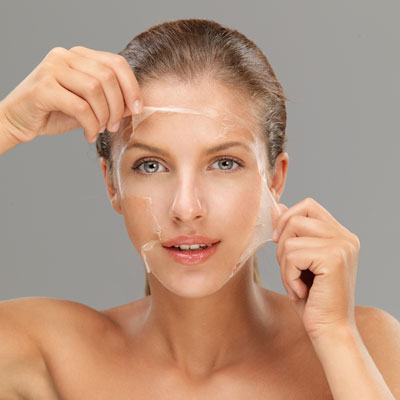Skin Peels/Chemical Peel
Exposure to sunlight, acne or getting older can make your skin wrinkled, spotted or scarred. If you want to restore the smoothness of the skin, it is better to consider a chemical peel. Chemical peel uses a chemical solution to remove the damaged outer layers of skin, thereby smoothening the skin texture.
Chemexfoliation or derma peeling is one of the best and least invasive methods to improve the appearance of your skin. Chemical peels are used frequently on the face. However, they can also be used to improve the texture of the skin on your neck and hands.
Chemical peel helps to improve:- Acne or acne scars
- Age and liver spots
- Wrinkles
- Freckles
- Skin pigmentation
- Rough skin and scaly patches
- Scars
- Sun-damaged skin

How does a chemical peel work?
Chemical solutions are cautiously applied to the skin to improve the texture by removing the damaged outer layers. Mostly, the chemicals used in the process are Phenol, Trichloroacetic acid and Alphahydroxy acids. The formula will be adjusted according to your specific requirements.
There are three types of chemical peels namely; Light Chemical Peel, Medium Chemical Peel and Deep Chemical Peel
Light Chemical Peel
Light chemical peel is recommended if you have irregular pigment, dryness, acne or fine wrinkling. This type of peel removes the outer layer of skin through exfoliation, consequently resulting in a healthier glow. These treatments could be done on a weekly basis, for up to six weeks in order to attain the desired results.
Medium chemical peel
Medium chemical peel is suitable if you have acne scars, deep wrinkles and uneven skin color. The chemicals used for this type of peel will help to eliminate skin cells from the outer layer of skin as well as the upper part of the middle layer of skin. Medium chemical peel could be done every 6 to 12 months.
Deep chemical peel
Deep chemical peel is recommended if you have deep facial wrinkles, damaged skin, scars, blotchy areas or pre-cancerous growths. Phenol is used to penetrate the lower dermal layer of your skin. A deep chemical peel generally requires pretreatment for up to 8 weeks.
Risks
Some of the risks associated with chemical peels are:
- Infection or scarring
- Temporary or permanent change in skin colour
- Abnormal pigmentation caused due to birth control pills, getting pregnant, or family history of brownish discoloration
- Reactivation of cold sores (herpes)
















